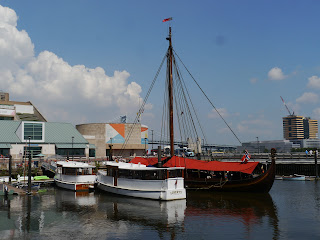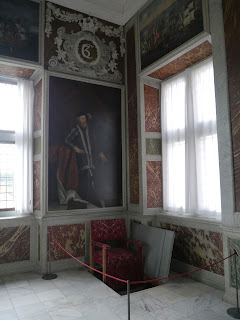The tour was only so-so. It really mattered who your guides were. We had Cormac in the front. Cormac saw the boat in Maine while on a friend's boat and decided he wanted to be a part of it. This was only his second day on the job. He was a great public speaker, but had no answers.
In the back we had someone else who was from Russia, who had answers, but a soft voice. His words disappeared into the wind.
As we were leaving we heard the next tour guide regaling his tour with stories about ancient sea travel and Norse mythology. I lingered as long as possible.
 I will admit I wanted to see this 10th century boat to see how it compared with Vasa, the boat we saw in Sweden. The short answer is: not really. The Vasa was built in the 17th century. It is MUCH larger than the Drakken. The Drakken was built as a war ship, the dragon on the front was meant to scare their enemies, and identify when the king was on board. When he left the boat (even for a few minutes) the dragon head came down. That was probably the neatest factoid I learned.
I will admit I wanted to see this 10th century boat to see how it compared with Vasa, the boat we saw in Sweden. The short answer is: not really. The Vasa was built in the 17th century. It is MUCH larger than the Drakken. The Drakken was built as a war ship, the dragon on the front was meant to scare their enemies, and identify when the king was on board. When he left the boat (even for a few minutes) the dragon head came down. That was probably the neatest factoid I learned. The Drakken is 115 feet from stem to stern, 26 feet wide, 260 square meters of silk sail, and a 79 foot tall mast made from Douglas fir. It sailed from Norway to the United States. Construction began in 2010. As the Vikings did not leave records about how they made their boats. This was was created using crashed warships and other artifacts. It is also modernized with things like fire extinguishers and life jackets, and an engine. The original Viking boats traveled from Norway to Newfoundland. This one traveled much, much further. With the engine, its top speed is 14 knots. Without them I think he said it was more like 4-6 knots.
The Drakken is 115 feet from stem to stern, 26 feet wide, 260 square meters of silk sail, and a 79 foot tall mast made from Douglas fir. It sailed from Norway to the United States. Construction began in 2010. As the Vikings did not leave records about how they made their boats. This was was created using crashed warships and other artifacts. It is also modernized with things like fire extinguishers and life jackets, and an engine. The original Viking boats traveled from Norway to Newfoundland. This one traveled much, much further. With the engine, its top speed is 14 knots. Without them I think he said it was more like 4-6 knots.The Drakken Harald sails with about 34-36 people on board. Viking ships of old traveled with 100 or more Vikings. They must not have cared as much about personal space in those days.
The boat is ornately carved with runes. I wish I had more time to study the details.
 |
| Ravens are from Norse Mythology: Huginn and Muninn |


































































